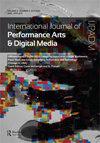XR Ulysses:解决布鲁姆斯戴取消的Joycean文学文化遗产现场再现的失望
IF 0.9
0 THEATER
International Journal of Performance Arts and Digital Media
Pub Date : 2022-01-02
DOI:10.1080/14794713.2022.2031801
引用次数: 8
摘要
摘要特定场地的演出是为特定地点制作的,可以在传统剧院之外的一个或多个区域进行。新冠肺炎封锁期间的社交聚会限制要求关闭这些节目。然而,应用新兴和新颖的移动数字技术的特定场地表演已经获得了令人信服的声音,展示了表演从业者和观众如何在封锁和现场表演模式改变的令人窒息的限制下进行,无论这些限制如何表现出来。尽管扩展现实(XR)技术已经发展了很长时间,但它们最近的成熟度激增为特定地点的表演者提供了新的潜力,他们可以探索将物理世界带入数字世界的方法,在共享的数字空间中重现真实世界的场所。在这项研究中,我们探索了数字XR技术(如体积视频、社交虚拟现实(VR)和摄影测量)在模拟特定地点剧院方面的潜在作用,从而评估了这些内容创作技术支持未来远程表演活动的潜力。我们专门报道了将现实世界中特定地点的性能用于VR。这种案例研究方法提供了例子,并就新冠肺炎后时代特定地点绩效的创新方法展开了对话。本文章由计算机程序翻译,如有差异,请以英文原文为准。
XR Ulysses: addressing the disappointment of cancelled site-specific re-enactments of Joycean literary cultural heritage on Bloomsday
ABSTRACT
Site-specific performances are shows created for a specific location and can occur in one or more areas outside the traditional theatre. Social gathering restrictions during the Covid-19 lockdown demanded that these shows be shut down. However, site-specific performances that apply emergent and novel mobile digital technologies have been afforded a compelling voice in showing how performance practitioners and audiences might proceed under the stifling constraints of lockdown and altered live performance paradigms, however they may manifest. Although extended reality (XR) technologies have been in development for a long time, their recent surge in sophistication presents renewed potentialities for site-specific performers to explore ways of bringing the physical world into the digital to recreate real-world places in shared digital spaces. In this research, we explore the potential role of digital XR technologies, such as volumetric video, social virtual reality (VR) and photogrammetry, for simulating site-specific theatre, thereby assessing the potential of these content creation techniques to support future remote performative events. We report specifically on adapting a real-world site-specific performance for VR. This case study approach provides examples and opens dialogues on innovative approaches to site-specific performance in the post-Covid-19 era.
求助全文
通过发布文献求助,成功后即可免费获取论文全文。
去求助
来源期刊

International Journal of Performance Arts and Digital Media
Arts and Humanities-Visual Arts and Performing Arts
CiteScore
1.70
自引率
0.00%
发文量
29
 求助内容:
求助内容: 应助结果提醒方式:
应助结果提醒方式:


